| Health Analytics and Business Affairs |
Administrative Services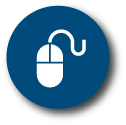
Goal: To provide effective and efficient support to all DRHD divisions, programs and services that help to enhance the delivery of the Ontario Public Health Standards and to meet all requirements of internal and external customers.
Accomplishments:
- Established the Business Affairs Divisional Staff Engagement Committee, which met several times to prepare for a divisional day expected to occur in spring 2025.
- Worked with a financial analyst to support financial management, including creating a framework for reviewing financial reports and following-up on variances, and setting up processes for monthly financial meetings with senior management.
- Completed work on the myDurham311 transition to enable a single access point for all Durham Region clients.
- Hired a temporary financial analyst who completed a thorough review of DRHD’s financials dating back to 2019.
Community & Resource Development (CARD)
Goal: To provide support to all DRHD divisions, programs, and services, helping to enhance compliance with the Ontario Public Health Standards.
Accomplishments:
- Developed and produced nine Medical Officer of Health video blogs, which were posted monthly on durham.ca and YouTube.
- Suspended the objective to relaunch a monthly video news program to promote DRHD programs, initiatives, and activities due to limited capacity for video production.
- Restored the team’s capacity by hiring a communications specialist, ensuring CARD is operating at full complement.
Health Analytics & Research Team (HART)

Goal: To ensure public health practice responds effectively to current and evolving conditions and contributes to the public’s health and well-being with programs and services that are informed by the population’s health status, including social determinants of health and health inequities.
Accomplishments:
- Worked on developing sustainable and efficient ways to supply staff with population survey data including Rapid Risk Factor Surveillance System, Ontario Student Drug Use and Health Survey, and Canadian Community Health Survey.
- Launched one internal infectious diseases surveillance dashboard with weekly refreshes that provides opportunities for staff to readily access data.
- Began foundational work on automating the data refresh process for Health Neighbourhoods, to support further updates.
- Published updated health statistics on durham.ca including two reports on the topics of mental health and young adult health behaviours.
- Published six infographics focused on syphilis, gonorrhea, chlamydia, West Nile virus, and infectious diseases.
- Provided weekly updates to two public data dashboards: the Respiratory Virus Data Tracker, and the Durham Region Opioid Information System.
Health Policy & Equity Team

Goal: Public health practice results in decreased health inequities so that everyone has equal opportunities for optimal health and can attain their full health potential without disadvantage due to social position or other socially determined circumstances.
Accomplishments:
- Worked on a staff needs assessment to inform a health equity capacity building strategy, which included a staff survey that received 205 responses.
- Worked with the Social Services Department through the Financial Empowerment Champions Committee (FECC) which involved participating in 11 Canada Learning Bond sign-up clinics, promoting communication initiatives regarding three topics related to financial empowerment, hosting six virtual learning sessions for staff, attending monthly meetings, and creating a web page for staff to access information and resources.
- Continued to develop a sociodemographic data strategy, including working with HART to launch and analyze a survey to identify staff learning and resource needs.
|
Mobile ID and Benefits Access Hub events
|
|
Financial empowerment (FE) is an approach to poverty reduction that aims to improve the financial security of people living with low income through a variety of interventions. The FECC aims to work collaboratively to identify gaps, partnerships and opportunities to integrate and advance FE efforts internally and in the community.
During 2024, the FECC hosted eleven Mobile ID and Benefits Access Hub events to promote the Canada Learning Bond (CLB). Through the CLB, the Government of Canada provides up to $2,000 for children from low-income households to deposit into a registered education savings plan (RESP) for their post-secondary education. In Durham Region, less than half (46 per cent) of eligible children and youth are accessing the CLB.
The Mobile ID and Benefits Access Hub events are intended to be a central place for families across Durham Region to access the CLB with multiple agencies working together. Service Canada is onsite issuing social insurance numbers (SIN) and Service Ontario updates identification for those who need it. Staff from Canada Revenue Agency also attends the events, sharing information about federal benefits and credits, and tax filing volunteers assist with tax form completion. Staff from the Social Services Department provides support with birth certificate applications. Local banks and RESP promoters assist with opening RESPs and CLBs. The Welcome Centre provides information for newcomers and DRHD staff offers resources about its programs and services for families.
In 2024, hub events served over 450 attendees. A total of 33 birth certificate applications were completed, 48 SINs were issued, 98 RESPs were opened, 129 CLB applications were submitted for a potential maximum of $258,000, and 59 tax returns were filed with an estimated $206,275 in benefits and credits unlocked.
Following the success of the hub events, additional dates are being offered in 2025. Visit durham.ca/CanadaLearningBond for information about upcoming events.
|
Privacy & Information Security
Goal: To provide effective and efficient privacy and information security support to all DRHD divisions, programs and services that help to enhance compliance with applicable privacy and public health related legislation, information security standards and information management best practices.
Accomplishments:
- Developed and piloted an asset inventory form for information systems and devices and began working with other divisions to tailor the form to their needs.
- Pilot tested an Ocean eReferral solution with DRHD's Healthy Families program to enable electronic client referrals to Ontario Shores Centre for Mental Health Sciences.
- Reviewed feedback from last year’s privacy staff learning sessions and prepared for a cyber security month initiative and privacy day/week.
|
| Health Information Systems and Quality Assurance & Improvement |
Health Information Systems - Health Protection
Goal: To maintain and develop the Hedgehog application including the Check&GO! disclosure portal and to support staff working toward achieving compliance with the Ontario Public Health Standards.
Accomplishments:
- Collaborated with Infectious Diseases Prevention & Control program staff to develop and implement an equitable public health inspector workload for staff supporting personal service settings and child care centres.
- Created a new procedure in the Hedgehog 5 (HH5) database to document adverse water quality and beach water monitoring surveillance reports for official record repository and post implementation evaluation.
- Explored, implemented, monitored and evaluated solutions to include beach water surveillance results on Check&GO! to increase public awareness.
- Prepared to upgrade the HH5 application for greater efficiencies and performance, starting with a pilot that identified errors and solutions prior to the full launch.
- Collaborated with the Community & Resource Development team to create a new page on durham.ca called "Your Business and Public Health" to share information and links to applications for people opening businesses that require inspection.
Health Information Systems - Population Health
Goal: To maintain and support the PROFILE application to meet requirements of documentation as per the applicable professional colleges, organizational policies and to meet reporting requirements for programs and services outlined in the Ontario Public Health Standards with an emphasis on continuous quality improvement.
Accomplishments:
- Implemented an enhanced onboarding and offboarding process for public health solutions.
- Developed a financial module in PROFILE to align with payment processes.
- Worked on a plan to identify records that meet criteria for destruction in PROFILE. Work will continue in 2025.
- Completed 655 monthly/quarterly reports for programs, 7,791 data quality clean ups, and 372 requests for system changes or enhancements.
Quality Assurance & Improvement
Goal: To ensure that programs and services meet requirements as articulated in policies, standards and legislation and to continuously improve the efficiency and effectiveness of services provided to Durham Region clients.
Accomplishments:
- Continued to evaluate and review records in the Hedgehog 5 database to ensure accuracy for operational and reporting needs and ensure proper disclosure and transparency to the public, which involved 428 verification checks.
- Evaluated and reviewed the process of onboarding Health Protection Division to official records to assure data accuracy, integrity and effectiveness for operational and reporting requirements.
- Developed and launched a two-day training to assist public health inspectors and tobacco enforcement officers in interacting with the community and the public, addressing discriminatory interactions, de-escalation and conflict resolution.
|
| Health Protection |

Durham Health Connection Line (DHCL) - Health Protection
Goal: To respond to inquiries and requests for service, including applications for new businesses and special event vendors from the community.
Accomplishments:
- Received and responded to 5,911 public inquiries through DHCL in the Health Protection Division.
- Continued efforts to collaborate with myDurham311 Change Agent Network.
- Assessed 369 special events and farmers’ markets to determine if the event or market will be inspected and reviewed 1,990 vendor applications.
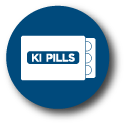
Emergency Management
Goal: To enable consistent and effective management of emergency situations.
Accomplishments:
- Planned, coordinated, and executed a two-day regional exercise in collaboration with Durham Emergency Management, Regional departments, and community partners.
- Launched an updated Emergency Management online training module for all DRHD staff.
- Planned and launched three potassium iodide (KI) communication campaigns to raise awareness about the availability and ordering process for KI tablets.
- Created and piloted a new virtual Health Operations Centre platform and completed the After Action Report.
|
Enhancing emergency preparedness
|
|
The Emergency Management Guideline, 2024 of the Ontario Public Health Standards highlights the importance of developing and conducting emergency exercises. These activities help staff stay prepared and ready to handle emergencies.
In May 2024, DRHD, in collaboration with regional and municipal partners, conducted the "Heat Dome" exercise to improve its emergency response to extreme heat events. This exercise simulated a severe heatwave with temperatures over 40°C, power outages, grass fires, and crowded hospital emergency departments.
The exercise tested the Health Operations Centre and the virtual platform (Microsoft Teams) for coordinating health responses. Key findings highlighted the effectiveness of the virtual model in facilitating remote coordination, streamlining information sharing, and enabling real-time decision-making. The exercise underscored the importance of effective communication, collaboration, and adaptability in managing emergencies, particularly during extreme heat scenarios.
Collaboration with regional and local partners was crucial. The After Action Report provided valuable insights and recommendations to strengthen emergency preparedness and response efforts. Recommendations included implementing comprehensive training programs, clarifying roles and responsibilities, standardizing documentation processes, and enhancing communication protocols. The report emphasized the importance of ongoing training and preparedness activities to ensure that staff is well-equipped for future emergencies.
In August, a respiratory planning exercise was conducted to help DRHD prepare for the expected respiratory surge in the fall. The planning exercise aimed to build on key lessons learned and ensure readiness for future outbreaks.
Through these initiatives, DRHD is committed to safeguarding public health and ensuring a robust response to future emergencies.
|

Food Safety
Goal: To prevent or reduce the burden of food-borne illness.
Accomplishments:
- Reviewed and revised mobile food premises processes to create a new pre-season process, which included sending informational letters and sharing a video blog that received 363 views to educate operators about re-opening after seasonal closures.
- Created a home canning/preserve video blog on items required before selling a product, including verified recipes, testing, inspected kitchen, etc.
- Worked on investigations with increased complexity, including one case involving farm market products that went to court.
- Completed quality assurance audits on all food safety inspection staff and identified areas of improvement to be addressed by future training.
|
Food safety in Durham Region
|
|
In 2024, DRHD worked hard to keep food safe for everyone. Through routine inspections, special events monitoring, and public education, the Health Protection Division (HPD) ensured food premises followed health regulations.
HPD staff completed 6,879 inspections across high-, moderate-, and low-risk food premises, along with 1,110 re-inspections. Staff also processed 1,990 vendor applications for 369 special events, making sure food at these events met safety standards.
HPD follows the Ontario Food Premises Regulation and the Health Protection and Promotion Act to guide its food safety efforts. The DineSafe Durham program helps residents make informed dining choices by posting inspection results both online and onsite. Premises receive a Pass (Green), Conditional Pass (Yellow), or Closed (Red) rating.
Beyond inspections, education plays a key role. In 2024, the Food Rap newsletter was re-launched after a break, sharing food safety updates. A special home canning video blog was also created to help both home canners and food operators learn best practices. Residents can find it on YouTube: Food Safety: Canning - YouTube.
HPD also responded to new food safety challenges, including home-based businesses, emerging food products, and complex food safety plans. By staying proactive, DRHD continues to ensure safe dining experiences for all residents and visitors.
|
 Healthy Environments Goal: To prevent or reduce the burden of illness from health hazards in the physical environment.
Accomplishments:
- Collaboratively developed a communication plan to promote key findings from the two completed Climate Change and Health Vulnerability Assessments reports, which included strategies for a variety of audiences.
- Built relationships and participated on climate and health knowledge exchange and community engagement networks and engaged with Mississaugas of Scugog Island First Nation and local municipalities on climate and health issues.
- Hosted a forum about the Heat Warning and Information System.
- Launched air quality alert notifications to community partners and created a new centralized email account to streamline communications (enviroalerts@durham.ca).
|
Public education and awareness on Lyme disease
|
|
In 2024, DRHD launched a comprehensive public education campaign to raise awareness about Lyme disease and promote preventive measures. This initiative was part of an approach to manage and prevent Lyme disease; a vector-borne disease transmitted by ticks.
The campaign included a variety of outreach efforts to educate the public about the risks of Lyme disease and how people can protect themselves. Social media posts and radio spots were used to reach a broad audience, providing information on the importance of using insect repellent, wearing long sleeves and pants, and performing tick checks after outdoor activities. Additionally, DRHD released a new educational video on durham.ca, further supporting these preventive measures.
|

Ontario Building Code - Part 8 (Sewage Systems)
Goal: To prevent diseases in humans and contamination of the physical environment due to on-site private sewage systems.
Accomplishments:
- Revised the priority related to producing a video blog about septic system maintenance, as staff identified an existing resource by the Ontario Onsite Wastewater Association (OOWA) that satisfied this need. Instead, DRHD promoted OOWA’s video blogs on durham.ca to educate homeowners on maintenance practices.
- Built relationships with two cottage associations and one community group to enable information sharing about private sewage systems with the public and community groups.
- Inspected 399 sewage systems within 100 meters of the shoreline/tributary of Lake Simcoe to prevent contamination, of which three properties required follow-up, and two property owners were issued warning letters for refusing entry.
Safe Water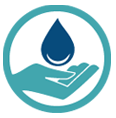
Goal: To prevent or reduce the burden of water-borne illness related to drinking water and to prevent or reduce the burden of water-borne illness and injury related to recreational water use.
Accomplishments:
- Promoted safe water messaging through social media on a monthly schedule, gaining 163,651 impressions, 132,839 reaches, and over 677 engagements.
- Inspected all recreational water facilities and monitored all public beaches in Durham Region, including 537 compliance inspections, 177 re-inspections, 18 complaint investigations, and sampling water at 14 beaches from June to September.
- Raised awareness for DRHD’s new online pool and spa operator training course through social media and direct communication with recreational water operators.
- Completed recreational water program consistency training for all program staff.
- Developed a policy and procedure for Chalk Lake Spring to address water quality issues.
- Completed 77 inspections of small drinking water systems.
|
| Healthy Families |
Durham Health Connection Line (DHCL) – Population Health
Goal: To ensure Durham Region residents have access to health information and counselling and referral to appropriate resources on health issues as outlined in the Ontario Public Health Standards.
Accomplishments:
- Responded to inquiries from the community through 13,360 telephone contacts and 526 email inquiries.
- Collaborated with staff across the division to deliver health education, counselling and referrals including 131 collaborations with program liaisons, sharing call reports with program areas, and 38 planned activities.

Pregnancy & Parenting, and Healthy Babies Healthy Children (HBHC)
Goal: To achieve optimal preconception, pregnancy, newborn, child, youth, parental and family health.
Accomplishments:
- Implemented six series of perinatal mood disorder cognitive behavioural therapy sessions, engaging 53 clients, of which most participants (76 per cent) demonstrated a reduction in their postnatal depression score afterwards.
- Developed a plan to support the healthy growth and development needs of children and families in identified neighbourhoods in Whitby, Oshawa, and Clarington with a focus on addressing identified areas of Early Development Instrument vulnerabilities.
- Completed 5,865 home visits to families identified with risk for compromised parenting and child development, while also completing 429 Partners in Parenting Education activities, and 543 Parent/Child Interaction assessments.
- Implemented a plan to promote the HBHC program and referral process to health care providers, community agencies and Durham Region residents, resulting in 3,744 prenatal, postpartum, and early childhood families screened for risk.
|
Cognitive behavioural therapy helping postpartum parents
|
|
Mental illness in the postpartum period is present in as many as one in four mothers in Canada. In late 2023, DRHD implemented cognitive behavioural therapy (CBT) groups due to a demand for perinatal mental health services in the community. DRHD’s CBT program is called Steps to Wellness: Before and After Baby. It is a nine-week group series facilitated by trained public health nurses for prenatal and postpartum parents experiencing symptoms of depression and/or anxiety. The series provides participants with skills, strategies and tools to help them manage their symptoms.
In 2024, DRHD held six CBT series with 53 clients registered. The clients completed a depression scale before and after the series. The results showed that 76 per cent of clients who completed the CBT series reported a reduction in their postnatal depression score. After the series, clients were also asked to complete a survey, where DRHD received positive feedback. Clients reported that they were able to use the tools, techniques, and strategies they learned to manage their mood and anxiety levels, they felt less self-doubt, and they felt increased confidence in their parenting.
|
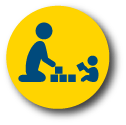
Infant & Child Development
Goal: To enhance the growth and development of children, including those with a developmental disability and/or risk of developmental delay by partnering with families to provide support, information, and early intervention services.
Accomplishments:
- Provided home visiting services for 823 children between the ages of birth to school entry.
- Provided resources and service coordination for families, helping 57 children transition to kindergarten and 103 children transition to a licensed early learning and care program.
|
| Healthy Living |
Chronic Disease Prevention
Goal: To reduce the burden of chronic diseases of public health importance* and improve well-being.
*Chronic diseases of public health importance include, but are not limited to, obesity, cardiovascular diseases, respiratory disease, cancer, diabetes, intermediate health states (such as metabolic syndrome and prediabetes), hypertension, dementia, mental illness, and addictions.
Accomplishments:
- Increased awareness of food insecurity to support advocacy efforts by completing an environmental scan of online food insecurity reporting, implementing a new format to annually monitor food affordability in Durham Region, adopting a protocol to assess the cost of healthy eating locally, completing a report on monitoring food affordability locally, and launching an information sharing campaign.
- Collaborated with six community partners to support advocacy efforts to address food insecurity.
- Raised awareness of supports for post-secondary students for nicotine and vaping cessation services, which involved doing background research, consulting with local post-secondary schools, developing resources, and launching a communication campaign.
Oral Health
Goal: To enable all children in Durham Region to attain and sustain optimal oral health and development potential, and to support adults who require assistance in accessing oral health information and services.
Accomplishments:
- Provided services in DRHD’s oral health clinic to over 4,522 clients through the Ontario Seniors Dental Care Program and over 721 Healthy Smiles Ontario clients.
- Deferred plans to offer dental care services in Durham Region’s long-term care homes until late 2025.
- Worked on a plan to deliver preventive, dental, and denture care services to eligible clients through publicly funded programs in collaboration with Brock Community Health Centre (BCHC). An agreement with DRHD and BCHC is expected in 2025.
- Reviewed the new Canadian Dental Care Plan (CDCP) and developed an implementation plan to provide preventive, dental, and denture care services to CDCP recipients.
- Offered and provided dental screening to all children in participating Durham Region schools, which included screening 42,996 children and identifying children with urgent and non-urgent dental needs, as well as children that were clinically eligible for preventive services.
- Conducted oral health promotion and education with a focus on children and seniors’ oral health care by attending schools, community events, community screenings, and providing health promotion messages on social media.
- Reestablished oral health services in priority child care settings, reaching 698 children.
- Began the analysis of pre/post COVID-19 school dental screening data, which will continue in 2025.
Prevention of Injury & Substance Misuse
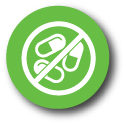
Goal: To reduce the burden of preventable injuries and substance use.
Accomplishments:
- Implemented a plan to increase awareness of alcohol-related harms among youth and young adults by doing background research, amplifying a campaign with Durham College and Ontario Tech University, promoting curriculum and providing 32 consultations to local schools.
- Implemented the local opioid response plan in coordination with Opioid Task Force members by participating in meetings, presenting information at Ontario Tech University, supporting the creation of a new dashboard to monitor local opioid-related statistics, promoting the National Overdose Response Service, distributing 4,950 naloxone kits plus 902 refills, and onboarding four new eligible organizations.
- Implemented a strategy for young adults to increase awareness of the health risks associated with cannabis use and harm reduction, which involved background research, consulting with Durham College and Ontario Tech University, and supporting two student outreach events.
- Completed a situational assessment on social prescribing to support the mental health of Durham Region residents and organized two networking meetings on the topic.
School Health
Goal: To achieve optimal health of children and youth in schools through partnership and collaboration with school boards and schools.
Accomplishments:
- Delivered public health interventions to school communities using a comprehensive school health approach, including completing 445 annual school assessments, 115 Healthy School Action Plans, 2,088 school interactions, and five training workshops with Healthy Living staff over the 2023/2024 and 2024/2025 school years.
- Implemented an evaluation plan of the revised human development and sexual health resources with educators who use the resources resulting in distribution of updated sexual health teaching kits, completion of an educator survey, and ongoing promotion of resources.

Smoke-Free Ontario Act, 2017
Goal: To ensure that tobacco, e-cigarette vendors, and other organizations that are subject to the Smoke Free Ontario Act, 2017 (SFOA) comply with the Act and to restrict youth access to tobacco products and e-cigarettes.
Accomplishments:
- Explored adding SFOA legal action (e.g., tickets, summons and legal files) into the Hedgehog 5 (HH5) database for records management and for disclosure on the Check&Go portal, and identified challenges and mitigation strategies to enable a roll out in 2025.
- Researched and implemented additional legal tools in collaboration with internal partners, for facility operators who are not compliant with the SFOA and Durham Region Smoking and Vaping By-law, where progressive enforcement does not achieve compliance, including Probation Orders, significant fines, and imposing business licensing requirements for tobacco and vapour product retailers.
- Explored a collaboration with the Health Analytics & Research Team to develop data related to youth vaping and non-compliance at tobacco and vapour retailers and determined the best approach would be to record these types of data in HH5.
|
Successful tobacco and vaping enforcement
|
|
In 2024, DRHD’s Tobacco Enforcement Officers (TEO) achieved a significant victory in their ongoing efforts to enforce the SFOA. One of the most notable cases involved a retailer that had been the subject of over 30 complaints concerning sales to minors and the use of social media platforms to sell vaping products to underage people.
The investigation has been ongoing over the last four years and during this period, TEO issued 74 charges for non-compliance under the SFOA, the Health Protection and Promotion Act (HPPA), and the Provincial Offences Act (POA). The provincial offences court outcomes were significant, with fines totalling $275,675 with $237,675 under the SFOA, $36,000 under the HPPA, and $2,000 under the POA. The director of the corporation was also issued a probation order that included 150 hours of community service and a prohibition on possessing or selling any nicotine delivery products.
This case highlights the effectiveness of DRHD’s enforcement efforts and the dedication of its TEO in protecting public health.
|
|
| Infectious Diseases |
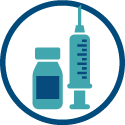
Immunization
Goal: To reduce or eliminate the burden of vaccine preventable diseases through immunization.
Accomplishments:
- Supported Immunization of School Pupils Act compliance in all students Grades 2, 5 and 6 in 219 elementary schools and in all Grades in 38 secondary schools.
- Provided provincially funded immunizations to all eligible Grade 7 and 8 students through school-based clinics at 193 elementary schools.
- Provided 80 immunization clinics for Durham Region residents with limited access to publicly funded vaccines, immunizing 2,722 people.
- Provided 35 COVID-19 vaccine immunization/homebound clinics for Durham Region residents with limited access to the vaccine, administering 809 vaccines.
Infectious Diseases Prevention & Control - Health Protection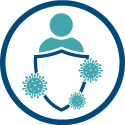
Goal: To reduce the burden of communicable diseases and other infectious diseases of public health importance.
Accomplishments:
- Developed a new vector-borne diseases education campaign about mosquito and tick bite prevention, which included radio ads, social media posts, outdoor signage, 11 education sessions, and two meetings with community partners.
- Updated and launched a new process for managing standing water complaints, in cooperation with the local area municipalities in relation to West Nile virus disease.
- Updated and launched a new legal process for following up on standing water complaints in relation to West Nile virus disease.
- Received and responded to all reported cases (1,583) of potential rabies exposures received from the public and community partners, administered rabies post-exposure prophylaxis (PEP) to 224 residents, and submitted 61 animals for rabies testing.
- Developed rabies educational messages for the public, which were shared though a news release and social media posts and released two ‘Fax Abouts’ on the topic of rabies PEP and reporting requirements for health care providers.
- Encouraged and supported local veterinarians and municipal animal services to host low-cost rabies immunization clinics by promoting the clinics on durham.ca, which resulted in five clinics being offered.
- Responded to all complaints (55) regarding infection prevention and control (IPAC) practices and/or referred people to the appropriate regulatory bodies, including regulatory colleges.
- Inspected all personal service settings (PSS) and licensed child care centres (CCC) for compliance with relevant regulations, protocols and guidelines, resulting in 1,864 inspections, and 13 Section 13 orders that were issued to PSS facilities.
- Launched two PSS newsletters for PSS operators.
- Explored the implementation of workshops for CCC operators in collaboration with the Social Services Department and implemented an update to the operator online learning module for CCC.
- Conducted investigations of diseases of public health significance (DoPHS) including 1,760 DoPHS cases reported and 650 DoPHS cases investigated, and 441 outbreak investigations (in acute care facilities, long-term care homes, retirement homes, congregate living settings, and CCC).
- Collaborated with Lakeridge Health to host the Durham IPAC Hub Education Day/Respiratory Event in October, which was attended by 170 people in-person and 20 people online.
- Collaborated with the Health Analytics & Research Team to launch the outbreak email notification/automation project.
- Revised and launched an IPAC online module for staff, which was completed by 452 DRHD staff, and 15 staff members from the Social Services Department.
- Completed larval and adult mosquito surveillance and mitigation, which included setting 15 adult mosquito traps for 16 weeks, monitoring 459 stagnant water sites, treating 684 stagnant water sites, treating approximately 65,000 catchbasins, investigating and resolving 37 standing water complaints, and monitoring 18 West Nile virus cases.
- Created a new online submission form for catchbasin treatment requests and referrals from municipal by-law enforcement officers.
Infectious Diseases Prevention & Control - Population Health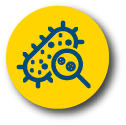
Goal: To reduce the burden of communicable diseases and other infectious diseases of public health importance.
Accomplishments:
- Managed 261 confirmed communicable disease cases and 250 contacts in accordance with the Infectious Diseases Protocol.
- Managed 55 suspected and confirmed cases of tuberculosis (TB) according to federal guidelines and provincial protocols, of which 39 were confirmed cases, in addition to managing 509 cases of latent TB infection, following 391 people for TB immigration medical surveillance, and providing 1,567 home and video visits for directly observed therapy.
- Managed 2,383 sexually transmitted and blood-borne infection (STBBI) cases and 66 contacts.
- Offered sexual health clinic (SHC) services at two locations, seeing 4,948 unique clients and having 14,371 clinic appointments.
- Evaluated the two SHCs, and results showed that nearly all (over 90 per cent) clients reported they: felt more confident in making sexual health decisions; were considering changes to lower their risk of STBBI; found the health education helpful; and learned new information.
|
Raising awareness about syphilis – An emerging epidemic
|
|
Syphilis is a sexually transmitted bacterial infection that can cause serious health problems if untreated. In Durham Region, there were twice as many syphilis cases in 2023 (191) than in 2019 (95). Nurses at DRHD follow up with all clients who test positive for syphilis, including arranging staging and treatment and close contact follow-up. DRHD services are confidential, and include private counselling using a nonjudgmental, culturally sensitive risk assessment that incorporates awareness of the stigma and discrimination that come with syphilis. Nurse practitioners at DRHD play a key role in providing accurate screening, staging, and treatment of syphilis, which is crucial to reducing the risk of long-term sequelae in cases and contacts.
At the 2024 Nurse Practitioners’ Association of Ontario Conference, nurse practitioners from DRHD delivered a poster presentation on the sharp (75 per cent) increase in infectious syphilis cases in Ontario between 2018 and 2022. The poster presentation highlighted diagnostic tools, clinical assessment, evidence-based treatment, and follow-up recommendations for managing syphilis, while emphasizing the critical role of primary care providers in early identification and intervention. Key strategies include routine screening, early recognition of symptoms and timely treatment to help prevent complications, including congenital syphilis which is also on the rise.
|
|
|
Paramedic Services
|
 Goal: Goal: To deliver a quality Paramedic Services system that is responsive to client needs and to reduce mortality and morbidity related to illness and injury through the provision of pre-hospital advanced life support procedures. Primary program delivery is through Region of Durham Paramedic Services with assistance from the Central Ambulance Communications Centre and local fire department tiered response programs.
Accomplishments:
- Responded to 147,639 calls for paramedic services across the region.
- Continued to implement the Paramedic Services Master Plan with appropriate staffing enhancements.
- The progress on the construction of the Seaton Response Station was delayed in 2024. Occupancy is anticipated in 2025.
- Sought opportunities for enhanced hours of operation within the logistics program to better support 24/7 business operation. Enhanced hours were proposed at bargaining, and a final decision is expected in 2025.
- Worked on the External Violence Against Paramedics training for all frontline staff, however the training launch was delayed. Training is expected to launch in 2025.
|
|
2024 Financial Information
|
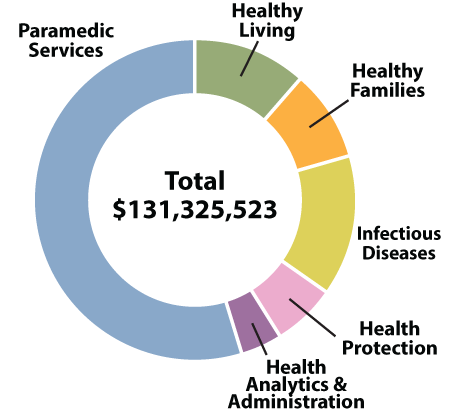 2024 Expenditures 2024 Expenditures
- Healthy Living ($15,328,233)
- Healthy Families ($12,063,288)
- Infectious Diseases ($18,524,671)
- Health Protection ($8,303,835)
- Health Analytics & Administration ($5,596,431)
- Paramedic Services ($71,509,065)
Total $131,325,523
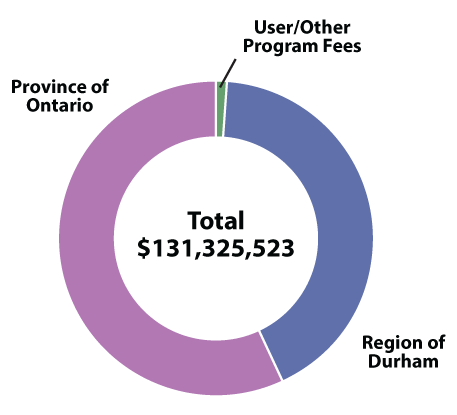
2024 Revenues
- Region of Durham ($54,947,724)
- Province of Ontario ($74,579,192)
- User/Other Program Fees ($1,798,607)
Total $131,325,523
|






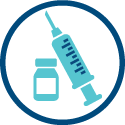




 Healthy Environments
Healthy Environments






 Goal: To deliver a quality Paramedic Services system that is responsive to client needs and to reduce mortality and morbidity related to illness and injury through the provision of pre-hospital advanced life support procedures. Primary program delivery is through Region of Durham Paramedic Services with assistance from the Central Ambulance Communications Centre and local fire department tiered response programs.
Goal: To deliver a quality Paramedic Services system that is responsive to client needs and to reduce mortality and morbidity related to illness and injury through the provision of pre-hospital advanced life support procedures. Primary program delivery is through Region of Durham Paramedic Services with assistance from the Central Ambulance Communications Centre and local fire department tiered response programs.













 2024 Expenditures
2024 Expenditures